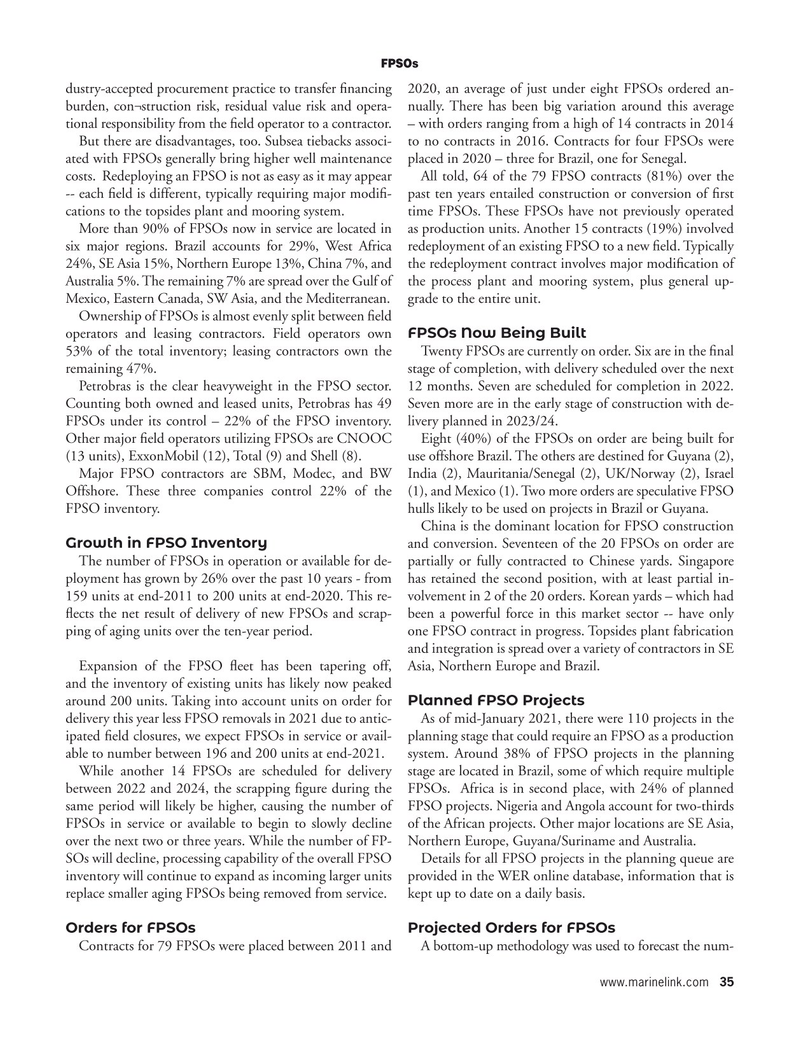
Page 35: of Maritime Reporter Magazine (February 2021)
Government Shipbuilding
Read this page in Pdf, Flash or Html5 edition of February 2021 Maritime Reporter Magazine
FPSOs dustry-accepted procurement practice to transfer ? nancing 2020, an average of just under eight FPSOs ordered an- burden, con¬struction risk, residual value risk and opera- nually. There has been big variation around this average tional responsibility from the ? eld operator to a contractor. – with orders ranging from a high of 14 contracts in 2014
But there are disadvantages, too. Subsea tiebacks associ- to no contracts in 2016. Contracts for four FPSOs were ated with FPSOs generally bring higher well maintenance placed in 2020 – three for Brazil, one for Senegal. costs. Redeploying an FPSO is not as easy as it may appear All told, 64 of the 79 FPSO contracts (81%) over the -- each ? eld is different, typically requiring major modi? - past ten years entailed construction or conversion of ? rst cations to the topsides plant and mooring system. time FPSOs. These FPSOs have not previously operated
More than 90% of FPSOs now in service are located in as production units. Another 15 contracts (19%) involved six major regions. Brazil accounts for 29%, West Africa redeployment of an existing FPSO to a new ? eld. Typically 24%, SE Asia 15%, Northern Europe 13%, China 7%, and the redeployment contract involves major modi? cation of
Australia 5%. The remaining 7% are spread over the Gulf of the process plant and mooring system, plus general up-
Mexico, Eastern Canada, SW Asia, and the Mediterranean. grade to the entire unit.
Ownership of FPSOs is almost evenly split between ? eld operators and leasing contractors. Field operators own FPSOs Now Being Built 53% of the total inventory; leasing contractors own the Twenty FPSOs are currently on order. Six are in the ? nal remaining 47%. stage of completion, with delivery scheduled over the next
Petrobras is the clear heavyweight in the FPSO sector. 12 months. Seven are scheduled for completion in 2022.
Counting both owned and leased units, Petrobras has 49 Seven more are in the early stage of construction with de-
FPSOs under its control – 22% of the FPSO inventory. livery planned in 2023/24.
Other major ? eld operators utilizing FPSOs are CNOOC Eight (40%) of the FPSOs on order are being built for (13 units), ExxonMobil (12), Total (9) and Shell (8). use offshore Brazil. The others are destined for Guyana (2),
Major FPSO contractors are SBM, Modec, and BW India (2), Mauritania/Senegal (2), UK/Norway (2), Israel
Offshore. These three companies control 22% of the (1), and Mexico (1). Two more orders are speculative FPSO
FPSO inventory. hulls likely to be used on projects in Brazil or Guyana.
China is the dominant location for FPSO construction
Growth in FPSO Inventory and conversion. Seventeen of the 20 FPSOs on order are
The number of FPSOs in operation or available for de- partially or fully contracted to Chinese yards. Singapore ployment has grown by 26% over the past 10 years - from has retained the second position, with at least partial in- 159 units at end-2011 to 200 units at end-2020. This re- volvement in 2 of the 20 orders. Korean yards – which had ? ects the net result of delivery of new FPSOs and scrap- been a powerful force in this market sector -- have only ping of aging units over the ten-year period. one FPSO contract in progress. Topsides plant fabrication and integration is spread over a variety of contractors in SE
Expansion of the FPSO ? eet has been tapering off, Asia, Northern Europe and Brazil. and the inventory of existing units has likely now peaked around 200 units. Taking into account units on order for Planned FPSO Projects delivery this year less FPSO removals in 2021 due to antic- As of mid-January 2021, there were 110 projects in the ipated ? eld closures, we expect FPSOs in service or avail- planning stage that could require an FPSO as a production able to number between 196 and 200 units at end-2021. system. Around 38% of FPSO projects in the planning
While another 14 FPSOs are scheduled for delivery stage are located in Brazil, some of which require multiple between 2022 and 2024, the scrapping ? gure during the FPSOs. Africa is in second place, with 24% of planned same period will likely be higher, causing the number of FPSO projects. Nigeria and Angola account for two-thirds
FPSOs in service or available to begin to slowly decline of the African projects. Other major locations are SE Asia, over the next two or three years. While the number of FP- Northern Europe, Guyana/Suriname and Australia.
SOs will decline, processing capability of the overall FPSO Details for all FPSO projects in the planning queue are inventory will continue to expand as incoming larger units provided in the WER online database, information that is replace smaller aging FPSOs being removed from service. kept up to date on a daily basis.
Orders for FPSOs Projected Orders for FPSOs
Contracts for 79 FPSOs were placed between 2011 and A bottom-up methodology was used to forecast the num- www.marinelink.com 35
MR #2 (34-49).indd 35 MR #2 (34-49).indd 35 2/4/2021 9:50:56 AM2/4/2021 9:50:56 AM

 34
34

 36
36
